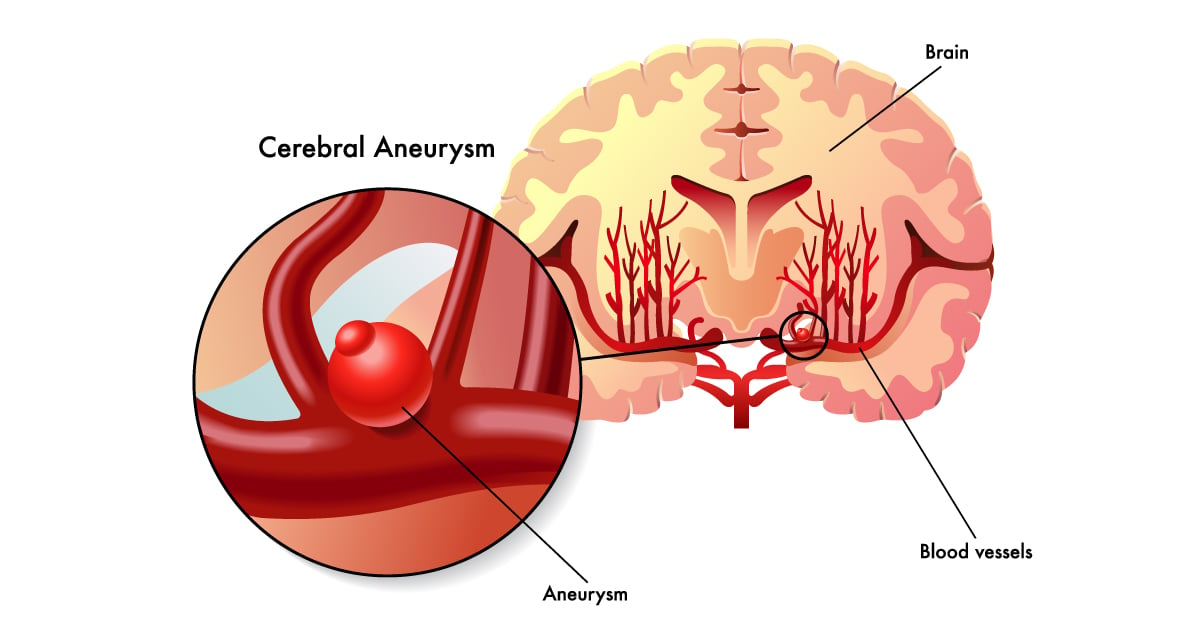Brain aneurysms are a common condition, often without warning signs. By the time it’s detected, symptoms are usually severe and sudden. It’s crucial to treat it as swiftly as possible before it’s too late, as the condition can be fatal, leading to paralysis and death.
What is a brain aneurysm?
A brain aneurysm (Cerebral Aneurysm) is a condition where the walls of the arteries in the brain deteriorate, causing them to thin. The blood pressure in that area can make the artery walls bulge. As it grows larger, the pressure in the blood vessels can cause it to rupture and bleed under the brain’s membrane. If there is a rupture, about half of the patients might die and the remaining patients need rapid diagnosis to avoid death due to lack of prompt treatment.
Causes of brain aneurysms
- Genetics or family history
- Age-related vascular degeneration
- High blood pressure
- Diabetes
- History of brain injury
- Smoking, using certain drugs
Symptoms of brain aneurysms
The frightening aspect of brain aneurysms is that in the early stages, there may be no warning signs or only non-specific headaches. As the aneurysm enlarges, it can press against brain tissue, block blood vessels, and cause ruptures, resulting in bleeding under the brain’s membrane. This leads to the following symptoms:
- A large brain aneurysm pressing against brain tissue or nerves The pressure’s effect depends on the position of the brain tissue near the blood vessel.
- Unilateral headache
- Droopy eyelid
- Double vision
- A large brain aneurysm with internal blood clots blocking distal blood vessels
- Numbness
- Weakness of the limbs
- Slurred speech
- Facial asymmetry
- A ruptured brain aneurysm with bleeding under the membrane is the most common symptom bringing patients to see the doctor.
- Severe sudden headache
- Sudden neck pain
- Nausea, vomiting
- Seizures, unconsciousness
How to diagnose brain aneurysms
- CT Scan to detect abnormal bleeding in the membrane
- MRI Scan to assess the risk of aneurysms, stenosis, and ruptures
-
- Initial diagnosis of abnormal blood vessels is determined by the treating physician based on the patient’s symptoms. Methods include CT-Angiogram, MRI-Angiogram and contrast angiography.
- Cerebral Angiogram is the current standard method that indicates the location, size, and shape of abnormal aneurysms. This method can also analyze abnormal blood flow and can be used to treat aneurysms without brain surgery, depending on the patient’s condition and the location of the abnormal vessels.

Treatment of brain aneurysms
The treatment of brain aneurysms depends on the patient’s symptoms
- If an aneurysm is detected incidentally, the patient can consult a specialist to plan treatment before it ruptures for better outcomes and quality of life.
- If a patient presents with symptoms of a ruptured aneurysm, it is a critical condition requiring urgent treatment.
- Inpatient treatment in the critical brain care unit
- Diagnosis of the aneurysm’s location and rupture to plan treatment
- Management of brain damage caused by bleeding, including acute hydrocephalus, seizures, ischemic brain symptoms, and unconsciousness, which can be life-threatening.
How to treat brain aneurysms
The treatment method depends on the aneurysm’s location, patient’s symptoms, age, amount of bleeding, patient’s health, and co-existing conditions. There are currently two main treatments:
- Clipping Aneurysm The neurosurgeon will clip the aneurysm based on the aneurysm’s size, shape, location, and base width. This method can clear cerebral bleeding and drain hydrocephalus simultaneously, reducing recurrence.
- Endovascular treatment A neuro-interventional radiologist will inject contrast dye for x-ray imaging before coiling the aneurysm with a platinum coil to induce clotting, occluding the aneurysm.
Preventing brain aneurysms
- Avoid sweet, fatty, and salty foods
- Control blood pressure within normal ranges
- Exercise regularly
- Avoid smoking, alcohol, and drug use
- Regular annual health check-ups
- If you have a chronic illness, take medication and follow medical advice consistently
Doctors specializing in brain aneurysms
- Dr. Yodruk Prasert, Neurosurgeon, Bone and Brain Hospital
- Dr. Nanthasak Tisavipat, Neurosurgeon, Bone and Brain Hospital
- Dr. Siraruj Sakoolnamarka, Neurosurgeon, Bone and Brain Hospital
- Dr. Parunut Itthimathin, Neurosurgeon, Bone and Brain Hospital
Hospitals specializing in brain aneurysms
The Bone and Brain Hospital is fully equipped to care for patients with brain aneurysms in any critical condition, leveraging an experienced team of specialists and modern technology to restore patients’ quality of life.
